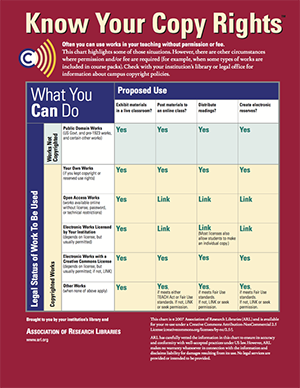Copyright & Fair Use

Copyright is a bundle of rights given to authors and creators to protect their original works. These rights are meant to allow authors some protection in how their works are copied, distributed, or performed. Copyright protection is broad but exceptions have been developed to balance out these rights. Fair Use is an exception that allows for use of copyright materials in limited circumstances, including for many educational purposes.
Copyright Basics
- Copyright is a form of protection for original works of authorship fixed in a tangible medium of expression.
- Copyright is grounded in the Constitution and is codified in Title 17 of the United States Code.
- Copyright can be claimed by the creator of the work, but copyright holders may not always be the creators.
- Copyright holders’ exclusive rights: reproduction, distribution, public performance in different format, distribution of works, and the ability to authorize others to exercise these rights.
- Works protected include but not limited to: literary, musical, dramatic, motion pictures, sculpture, etc.
- What is not protected: ideas, works that are not in tangible forms, titles and names, familiar symbols, lists of ingredients or contents.
Fair Use
Fair use is an exception to copyright that allows for materials to be used in limited circumstances, often for educational purposes.
- Use copyrighted material for a limited and transformative purpose, such as to comment upon, criticize, or parody.
- Four Factors to decide fair use:
- The purpose and character of your use,
- The nature of the copyrighted work,
- The amount and substantiality of the portion taken, and
- The effect of the use upon the potential market.
Technology, Education, and Copyright Harmonization Act (TEACH Act)
The TEACH Act allows for the use of copyrighted works for distance or online education in limited circumstances and under certain conditions.
- The institution must be an accredited, non-profit educational institution.
- The use must be part of mediated instructional activities.
- The use must be limited to a specific number of students enrolled in a specific class.
- The use must either be for live or asynchronous class sessions.
Other Resources on Copyright and Fair Use
Contact Information
The University Library is available to meet with individual and small groups to provide information about copyright, authors' rights, and publishing agreements. The team can also provide instruction or workshops to larger campus groups as needed. Contact the Publishing & Scholarship Support Team.
Disclaimer
This website was developed to provide information and resources on copyright for use by the faculty, staff, and students of California State University, Sacramento. The University Library makes every effort to ensure that the information is current but does not offer legal advice.

